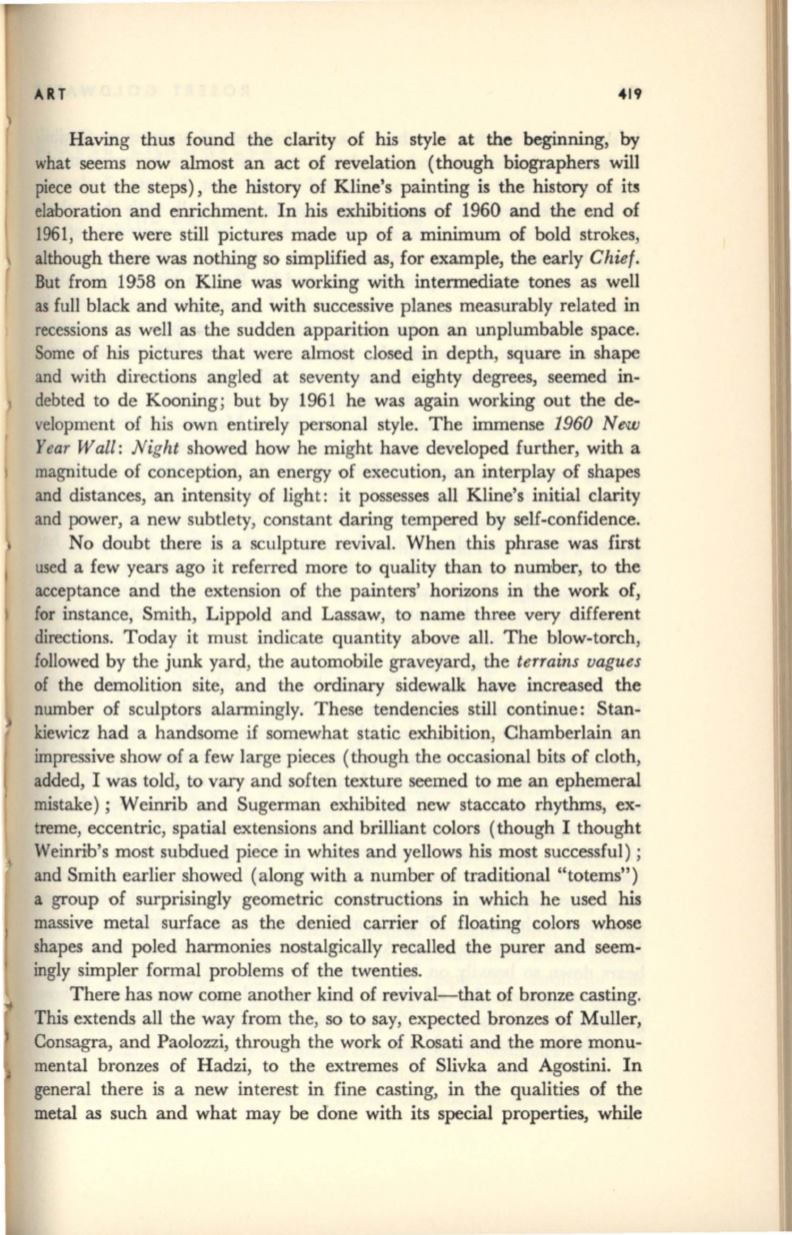
ART
419
Having thus found the clarity of his style at
the
beginning,
by
what seems now almost an act of revelation (though biographers will
piece out the steps), the history of Kline's painting is the history of its
elaboration and enrichment. In his exhibitions of 1960 and the end of
1961, there were still pictures made up of a minimum of bold strokes,
although there was nothing so simplified as, for example, the early
Chief.
But from 1958 on Kline was working with intennediate tones as well
as full black and white, and with successive planes measurably related in
recessions as well as the sudden apparition upon an unplumbable space.
Some of
his
pictures that were almost closed in depth, square in shape
and with directions angled at seventy and eighty degrees, seemed in–
debted to de Kooning; but by 1961 he was again working out the de–
velopment of his own entirely personal style. The immense
1960 New
Year Wall: Night
showed how he might have developed further, with a
magnitude of conception, an energy of execution, an interplay of shapes
and distances, an intensity of light: it possesses all Kline's initial clarity
and power, a new subtlety, constant daring tempered by self-confidence.
No doubt there is a sculpture revival. When this phrase was first
used a few years ago it referred more to quality than to number, to the
acceptance and the extension of the painters' horiwns in the work of,
for instance, Smith, Lippold and Lassaw, to name three very different
directions. Today it must indicate quantity above all. The blow-torch,
followed by the junk yard, the automobile graveyard, the
terrains vagues
of the demolition site, and the ordinary sidewalk have increased the
number of sculptors alarmingly. These tendencies still continue: Stan–
kiewicz had a handsome if somewhat static exhibition, Chamberlain an
impressive show of a few large pieces (though the occasional bits of cloth,
added, I was told, to vary and soften texture seemed to me an ephemeral
mistake) ; Weinrib and Sugerman exhibited new staccato rhythms, ex–
treme, eccentric, spatial extensions and brilliant colors (though I thought
Weinrib's most subdued piece in whites and yellows his most successful);
and Smith earlier showed (along with a number of traditional "totems")
a group of surprisingly geometric constructions in which he used his
massive metal surface as the denied carrier of floating colors whose
shapes and poled harmonies nostalgically recalled the purer and seem–
ingly simpler formal problems of the twenties.
There has now come another kind of revival-that of bronze casting.
This extends all the way from the, so to say, expected bronzes of Muller,
Consagra, and Paolozzi, through the work of Rosati and the more monu–
mental bronzes of Hadzi, to the extremes of Slivka and Agostini. In
general there is a new interest in fine casting, in the qualities of the
metal as such and what may be done with its special properties, while


